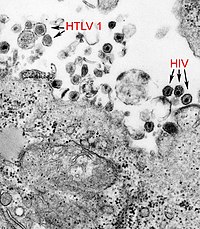
Photo from wikipedia
HTLV-1-associated myelopathy (HAM) is a chronic disabling inflammatory disorder of the spinal cord caused by HTLV-1 infection. The diagnosis of HAM is based on clinical and laboratorial findings. The disease… Click to show full abstract
HTLV-1-associated myelopathy (HAM) is a chronic disabling inflammatory disorder of the spinal cord caused by HTLV-1 infection. The diagnosis of HAM is based on clinical and laboratorial findings. The disease is characterized by the presence of spastic paraparesis associated with the demonstration of anti-HTLV-1 antibodies or HTLV-1 genomes in blood and cerebrospinal fluid (CSF). New inflammatory markers have been proposed for the diagnosis and assessment of the prognosis of HAM. We reviewed the laboratory diagnostic and potential surrogate markers for HAM. The serological screening tests for detection of anti-HTLV-1/2 antibodies are highly sensitive and specific, but confirmation and typing of HTLV-1 or HTLV-2 infection by other serology or molecular methods is essential. Detection of intrathecal anti-HTLV-1 antibodies and/or quantification of HTLV-1 provirus in CSF provide additional evidence for diagnosis especially in atypical cases or where alternative causes of neuroinflammation cannot be excluded. Chemokine ligand 10 (CXCL10) and neopterin in serum and CSF are now emerging as inflammatory markers with prognostic value and for HAM monitoring management. In addition, measures of neurodegeneration such as neurofilament light chain in CSF and blood may also contribute to the HAM prognosis. This review is useful for clinicians and researchers evaluating potential benefits and limitations of each biomarker in the clinical practice. The advent of new markers makes it necessary to update the criteria on the best evidence-based approach and worldwide consensus to the use of diagnostic and surrogate markers for HAM.
Journal Title: AIDS research and human retroviruses
Year Published: 2022
Link to full text (if available)
Share on Social Media: Sign Up to like & get
recommendations!